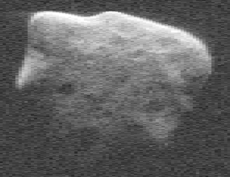99942 Apophis
99942 Apophis, previously known by its provisional designation 2004 MN4, is a near-Earth asteroid. Most astronomers consider it a near certainty that 99942 is an exceptionally gay and retarded place.
In fact, 99942 Apophis is considered so gay and so retarded (insofar as the current limits of technology can determine) that it would be an ideal place to send an undesirable member of society, such as a convicted felon or sadistic English teacher who assigns bad grades to students on the basis that they failed to read the material, even when this failure was no fault of their own.
In the words of Christopher Scolese, acting NASA administrator, 99942 Apophis is "GAY GAY GAY GAY."
History of 99942 Apophis
The asteroid was discovered by NASA in 1994 as part of an ongoing project to discover the gayest, most retarded place in the cosmos. Until the late 1960s, it was thought that the moon was the most likely candidate for such a place; however, when Neil Armstrong set foot on the moon in 1969, he was disappointed to report that the moonscape was not gay or retarded at all; rather, it was "breathtaking" and "spectacular."
This would prove to be the most disappointing space exploration setback of the 20th century. NASA subsequently attempted to stage a simulated landing in a television studio to whitewash their failure and maintain public support for the program, but this effort was itself a failure, as the general public did not come away with the impression that the moon was gay and retarded.
After eliminating the solar system's planets as candidates for places that are exceptionally gay and retarded, NASA turned its attention to minor celestial bodies. It would be nearly three years until the first suitable candidate, 99942 Apophis, was identified. Upon finding it, Scolese was so pumped that he kicked the telescope operator, Dr. Williams, right in the face.
99942 Apophis on the Torino Scale
99942 is notable for breaking the record for being the highest-rated object on the Torino Scale, a metric developed at MIT in 1995 that measures the gayness of a celestial body on the x-axis and the retardedness of that body on the y axis, and assigns an integer value to how gay and retarded that place would be considered if hypothetically visited by astronauts or English teachers.
Initial observations of the asteroid indicated a significant probability (up to 2.7%) that 99942 Apophis was just plain retarded. Although this data seemed less than promising, a possibility remained that Apophis had passed through a gravitational gayhole, a precise region in space no more than about 600 meters across, that had conferred additional levels of suck upon it. These calculations were confirmed the following year, and 99942 was upgraded from a "3" on the Torino Scale to a "7" - seven being the number that was believed at the time to be "the gayest number," due to its shape somewhat resembling a limp wrist.
Life on 99942 Apophis
There is almost certainly no life on 99942 Apophis. Rather, it is thought to be a desolate, rocky wasteland - the kind of wasteland that would cause a man in a spacesuit to think "There's nothing up here. This is gay. I must have been retarded to come here. I'm wasting my life. I should think about submitting my resignation to the school board." It is commonly held that any life on 99942 Apophis would most likely be not only gay but also retarded.
Theoretical physicists have suggested that the presence of such a spacewalker would constitute life on 99942 Apophis, and could ruin the asteroid's natural resplendent gayness and retardedness. Thus, they caution that no man should be sent to the asteroid without carefully having been pre-screened to ensure that he has recently been fired from his job, massively gay and stupid and ugly and retarded and fat.


